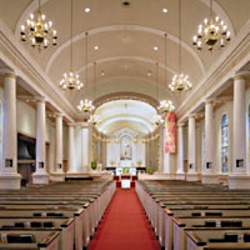
What To Ask For
Good delay doesn’t just happen; it takes some planning and budget, and it all comes down to time and money.
I have seen many systems, usually from a low bid, that aren’t up to what is required.
The only thing worse than not having delays is having blown or distorted delays.
The more you plan, the better you can use and defend your budget.
The first consideration is the type of event or range of events being bid on. The loudest material creates a minimum requirement. A big balcony may dictate delay boxes as big as the mains.
The more bandwidth the delay system delivers, the more natural it sounds. Warm vocal reproduction cannot be achieved without a phase coherent box that goes down to at least 100Hz.
The cabinets should be small enough for minimum visual impact but big enough for bandwidth and level impact.
Delays mean more outputs, so the second consideration is the desk. It must have matrix outputs. Feeding signal to delays is generally done with matrix outputs. This allows the mix to be altered for different zones.
Connecting the boxes is usually done with 16-gauge or smaller cable. Do not skimp on wire gauge. The length of run can get to hundreds of feet, and the added impedance makes it difficult for the amps to tightly control the cones, adding low-mid problems.
A minimum 14-gauge cable is needed with 12 and 10 gauge even better. The difference can be heard.
Another consideration for a musical is the pit orchestra. Will there be separate orchestra and vocal systems? Usually if there are separate systems, the delays will be vocal only but there are exceptions.
Plenty of orchestra may be in the balcony, but the main floor could be hollow because all the direct energy travels upstairs.
The solution is more output mixes to separate floor delays and balcony delays to rebalance the pit. Also relative to matrix size are how many balconies, their depth and width? How many side boxes? Many times, these need a different mix balance because of more interaction with the main system.
Can box patterns overlap in an aisle? This will affect the box coverage patterns necessary.
Where can we hang all these speakers? Are there balcony rail positions available? Do we install unistrut or is a delay truss advisable? Are the speakers in sight lines? Will the spotlights hit them? Can we get cable to them?
The director or producer will scream if the speakers hang in the wrong spot or start costing too much. So you (as the engineer) will have to make the case for extra cabinets, cable, electronics, amps, rigging, labor and time. They will scream much louder if they can’t hear or can’t sell as many top price seats.
